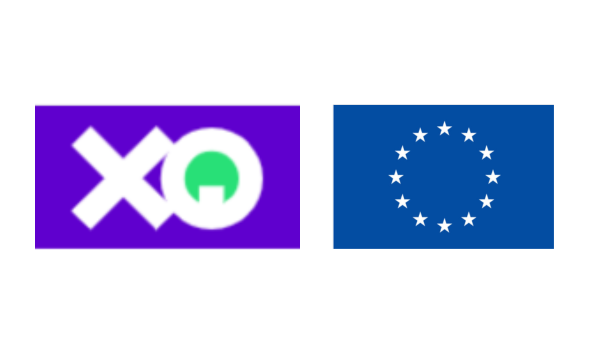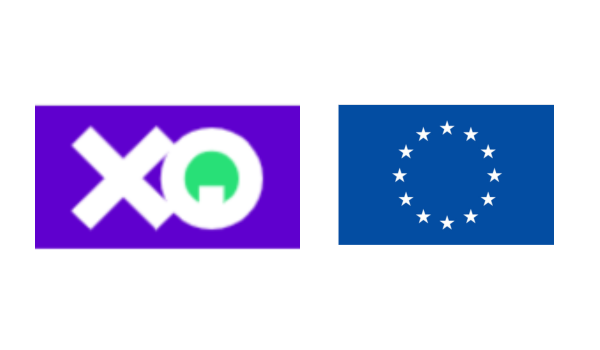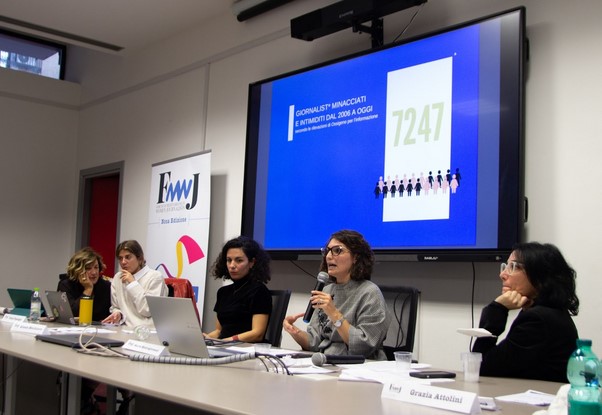A group of expert women gathers to discuss the current challenges and future of journalism at the 2024 Mediterranean Women Journalists Forum.
Beep. A notification pops up on my phone screen: Your flight to Bari is now boarding. I have never been to Bari. In fact, this is my first trip to Italy since I was three years old. That was a long time ago, I think—twenty years have passed since then, and so have many events. From my awful interpretation of Dorothy in my primary school theater play to graduating as a journalist, they were all unpredictable.
Oh no, I think again. The air hostess is bringing a metal stool to measure our cabin baggage. I hope I’m not screwed, I beg in silence. It takes a little bit of pushing, but I manage to fit my very full backpack into the very small box. A feeling of uncertainty runs through my veins. Twenty seconds pass, and the air hostess looks at me. She seems disappointed—she won’t be able to charge me extra for it. Battle win, I whisper.
I’m now crossing the path towards the airplane, but the butterflies in my stomach remain. This plane takes me to the unexpected: a new city, new colleagues, and the Forum of Mediterranean Women Journalists.
Palestinian journalists in the midst of genocide and hegemonic narratives
My plane lands at night in Bari, the capital of Puglia, a lesser-known region in the south of Italy. I’m excited but nervous. The following morning, on November 26th, I quickly get ready for the first panel I am attending: Palestine, a Live Genocide? It features two Palestinian women journalists—Wessal Yousef, reporting from the West Bank, and Jumana Shaheen, displaced in Cairo. For them, the massacre taking place in the Gaza Strip was unexpected in every way. In Shaheen’s words, it is “a crisis without precedent.” During their conference, they depict the harsh reality faced by thousands of innocent people who have become victims of widespread violence. They recount having to flee their homes without warning, often not knowing where to go, where to eat, or simply what to do.
Many of the victims were journalists who, although accustomed to dealing with the unexpected, were not prepared to become one of the main targets of the Israeli government. According to the barometer of Reporters Without Borders and the data provided by Yousef and Shaheen, more than 130 journalists have been murdered during the first year of this conflict.
As described by the two professionals, Palestinians have been treated as second-class citizens since the Israeli occupation of 1967. In the words of Micol Meghnagi, a sociologist invited from the University of Bologna, “Those who speak of coexistence are hypocrites, because there is a de facto system that makes Palestinian voices have less value.”
Shaheen states that genocide is happening and that “everybody is watching; it feels humiliating.” Although the Gazan reporter’s connection is weak, her voice trembles as she speaks those words. It feels as if the world considers the stories of journalists inside Gaza as second-class. Wessal Yousef, therefore, declares, “Being a Palestinian female journalist implies the responsibility to talk about your people and their suffering, to raise their voices to the eyes of international media with the tools of journalism and collective memory.” This sentiment is shared by the last panelist, Cecilia Dalla Negra, head of the Italian section of Orient XXI: “As journalists, we must support and protect our Palestinian colleagues and restore our reputation.”
A question comes to my mind at the end of the conference. I take my notebook as quickly as I can and write: How can we, as women journalists, face the challenge of the unexpected? An after-talk with Wessal Yousef about her experience as a Palestinian woman in journalism may shed some light. “The feminine story is really different from the male one. We can talk about marginalized places and stories with a sensitivity that does not usually attract much attention. For example, the stories of women in Area C (the fully Israeli-controlled territory in the West Bank) who, after the attacks on October 7th, were deprived of humanitarian aid and sexual reproductive care,” she asserts. In other words, journalistic routines, which are exceedingly masculine, tend to address events systematically and predictably. In contrast, the feminine perspective offers a potential and alternative way to cover the unexpected.
Kurdish women are challenging male dominated media narratives.
A pause for coffee takes place; it’s around 11:30 a.m. I remain seated, observing how the young students behave. They dress differently from one another but somehow share a lot in common. Some chat and exchange their thoughts on the first panel, while others get distracted by social media. What they don’t expect is that the second talk, starting in half an hour, will be transformative. Jineolojî: The Women’s Revolution in Kurdistan features Necibe Qeredaxi, a Jineolojî Academy activist from Iraqi Kurdistanê (Iraqi Kurdistan), and Gulistan Ike, a journalist from Newaya Jin in Bakurê Kurdistanê (Turkish Kurdistan).
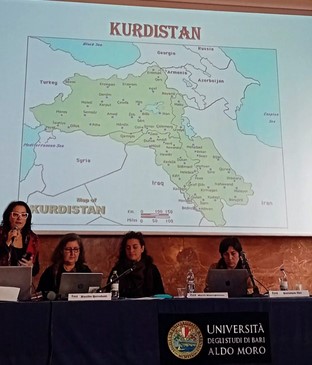
“Kurdistan is a stateless nation,” affirms Necibe Queredaxi. Throughout its history, the Kurdish people have endured five main occupations, leading to the spread of their population across Turkiye, Armenia, Syria, Iran, and Iraq. Under the threats of cause and effect, they have become a persecuted minority in all these states, enduring what can be described as a silent genocide. It was only two years ago that the #MeToo movement flooded the streets of major cities around the world to demand justice for 22-year-old Kurdish woman Jîna (Mahsa) Amini, murdered by Iranian police, supposedly for not wearing her hijab correctly. The world did not expect it, but for the Kurdish people, it’s routine. Marilù Mastrogiovanni, chair of the panel and organizer of the Forum of Mediterranean Women Journalists, interrupts briefly. “Her name was not Mahsa Amini but Jîna Amini. That was her real name in Kurdish, although they have tried to erase it,” she says.
To Necibe Queredaxi, “women are the last colonization in history.” Her conference revolves around Jineolojî, a holistic approach that bridges science and society, particularly focusing on revolutionary tasks and sociology. According to Queredaxi, the aim of this discipline is to advocate for a life free from the influence of patriarchy, abusive power dynamics, and capitalism. The history of the movement dates back to the foundation of the Kurdistan Workers’ Party (PKK) in the 1970s, as it considered the freedom of women a central axis for collective emancipation. Today, academic groups and research centers set the basis of Jineolojî, although the future of the movement remains uncertain.
A brief silence fills the room. As the conference has been presented in Kurdish, the translator is finalizing the last details with the second panelist. We are running out of time, so they need to be quick. Music begins to play softly in the background; it’s from a video. Projected on the screen are images of a woman, presumably a journalist, during her life. It appears to be a commemorative video for Ayfer Serce, a Kurdish reporter with Turkish citizenship who was murdered by Iranian authorities. Gulistan Ike begins explaining that “the journalism of Kurdistan is that of war; we have been exposed to genocide, colonialism, and patriarchy.” She adds that Rojava, a self-determined territory in Northern Syria, has been attacked several times by Turkish drones targeting journalists. Enforced disappearances of journalists have also been a practice of foreign governments to silence the Kurdish people, Gulistan Ike says.
As journalists, we are not trained to deal with censorship or oppression; it is unexpected to us. Another question comes to mind, and a note as well: How can we, as women journalists, deal with media control? However, I immediately cross out my question, since Ike may have an answer. She works at a women-owned media outlet, Newaya Jin, whose principles are those of Jineolojî: women, ecology, and democracy. But most importantly, media freedom. Creating independent journalism and community may be the answer to dealing with the unforeseen.
Education and new approaches as a solution to attract young people
It’s lunchtime, and I decide to take the orecchiette all’amatriciana, a staple of Puglia in terms of pasta shapes. Around 3 p.m., the next panel takes place, so I have to hurry. This time, the focus shifts from conflict to the potential of journalism as a pedagogical tool. The conference begins with Paula Estalayo, project coordinator of Octaedro, and Laura Casamitjana, editor of XQ The News. They present their project, XQ The News, a journal that aims to provide quality information on current events accessibly, incorporating different languages, two levels of reading comprehension, and other interactive resources.
Their speech is, however, interrupted. Unexpectedly, the chair announces that Bisan Owda, a filmmaker reporting from Gaza and Emmy-nominated, is connecting live from the refugee camp. During her brief intervention, she argues that “the information in the West does not even depict a fraction of the entire image.” Internet and communications have been a primary target for the Israeli forces, hindering the proper development of journalism. This is why Owda advocates for “talking about Gaza, as it is our duty to inform truthfully, and we must protect journalists.” In the long run, “we have a responsibility to educate the next generation so they can analyze the information that they are getting,” as Fiona Govan, a journalist based in Madrid and invited to this panel, summarizes it afterwards.
Although Owda’s speech may seem unrelated to the current panel, not everything is as it appears. Her video introduction, “It’s Bisan from Gaza, and I’m still alive,” has resonated deeply with Gen Z, aligning with the interests of a millennial audience. She has managed to address an issue that traditional media outlets failed to predict: the frustration of Gen Z with the news. This is the focus of the next panelist, Valentina Isernia, a journalist from Idea Dinamica, who continues the discussion.
How can we attract young people? I jot down in my memo pad. As she explains, “The youth is frustrated with traditional news because it is extremely negative.” Moreover, “They consume news indirectly,” primarily via social media. This is why Owda’s approach—short videos and a relatable tone—has set a benchmark for how to engage younger generations.
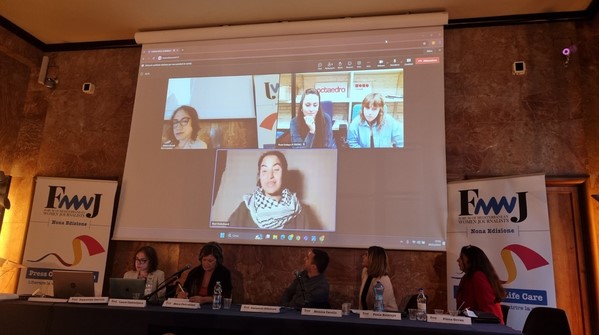
Valentina Isernia surprises us with another solution to attract young adults: gamification. Perhaps video games may cross the border of journalism and become a resource to inform them. According to her, they are complementary and a useful tool to explain overwhelming information. Moreover, Isernia emphasizes the importance of transmedia communication with an illustrative example. Last year, a bullying case made headlines in Italy. From this event, the victim’s family organized workshops and activities to raise awareness of the issue, which eventually led to the production of a film that once again made headlines. In her opinion, this circular process helps expand the reach of the media.
As the sun sets, signaling the close of the day’s final panel, a sense of urgency fills the air. Attendees quickly don their coats and gather their belongings, each heading in different directions, unsure of when their paths will cross again. Such is the nature of journalism. Throughout the day, the panelists—each with unique backgrounds—shared diverse opinions on the challenges facing journalism, yet none were able to predict its future. This is the reality we face: we work with the present, and predicting the future remains elusive. Be that as it may, the Forum of Mediterranean Women Journalists has provided us with the tools to navigate the unexpected: a feminine perspective to challenge male-dominated narratives, a commitment to media independence, and a dedication to incorporating education into our practice.
